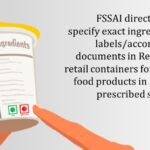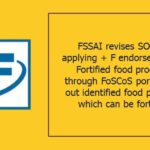The Food Safety and Standards Authority of India has recently issued some facts about milk and milk products in a question and answer format. Few of them are as follows:
- What is meant by SNF and total solids in milk? Is there any regulatory requirement for this parameter?
Answer: SNF or solids not fat is that nutrient portion present in milk which is other than milk fat and water. It consists of protein (primarily casein and lactalbumin), carbohydrates (primarily lactose), and minerals (including calcium and phosphorus.) When SNF is combined with milk fat, then it is called total solids.
Yes, Food Safety and Standards (Food Product Standards and Food Additives) Regulations, 2011 prescribe fat and Solids not fats (SNF) for different types of milk. For example -The legal standard for standardized milk is 4.5% fat and 8.5% SNF and the total solids are 13%.
- Can milk be fortified with vitamins and what are the regulatory requirements?
Answer: Yes, Toned, double toned, skimmed milk or standardized milk can be fortified with vitamins A and D, at the level prescribed in Food Safety and Standards (Fortification of Foods) Regulations, 2018.
- What is lactose intolerance?
Answer: Lactose is the milk sugar present in milk. It acts as a source of energy not only for the individuals who consume milk but also for the microorganisms in milk. Normally, lactose is converted in to glucose and galactose, which are subsequently converted in to lactic acid and absorbed in the intestine. Beta galactosidase is the enzyme that plays a major role in the conversion of lactose in to lactic acid. Lactose intolerance develops when the secretion of enzyme beta galactosidase decreases. Undigested lactose absorbs excess water, while passing through the large intestine. Bacteria present in large intestine act on the lactose and convert it in to acid and gas. This acid, gas and excess water are responsible for flatulence, stomach pain and sometimes enteritis.
- What is lactose free milk?
Answer: Low Lactose or Lactose free milk means the product prepared from any type of milk, in which, lactose content has been reduced significantly through hydrolysis by enzymatic or any other appropriate process. Standards for lactose free/low lactose milk have been framed and are in the process of draft notification.
- Q. Is there classification of milk as A1 and A2? Which one is beneficial to health?
Answer: Standards of milk as specified in Food Safety and Standards (Food Product Standards and Food Additives) Regulations, 2011 do not mention/recognize any differentiation of milk on the basis of A1 and A2 types.
Although the issue regarding adverse/beneficial effects of A1 and A2 types of milk have been discussed in various meetings of Scientific Panel on Milk and Milk Products, the panel did not come to any conclusion on this issue due to lack of clinical data/risk assessment done at scale so far.
Source: Food Safety and Standards Authority of India




